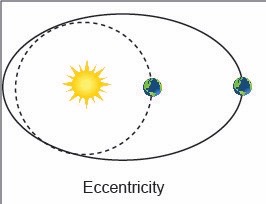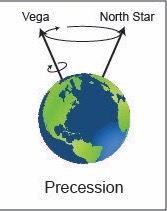Milankovitch cycle
Milankovitch cycles are three ways the Earth's orbit around the Sun changes over the course of tens of thousands of years. Each of the three, eccentricity, axial tilt and precession all influence how much solar energy hits the Earth. This change has been a major factor controlling periods of glaciation and seasons.[1] These cycles were discovered and mathematically developed by after astrophysicist Milutin Milankovitch. The three components once calculated together, predict and show the amount of solar radiation the Earth receives thus predicting and portraying the advances and retreats of Earth’s glaciers through time.[2]
The Three Variations
Eccentricity

Eccentricity is the path of Earth’s orbit around the sun. Over a period of 100,000 years, this varies from low eccentricity to higher eccentricity (it never gets too eccentric). A low eccentric shape means the Earth will travel around the Sun in a more circular fashion with either none or a very low percent difference between it’s farthest distance (aphelion) from the Sun to its closest distance (perihelion). Earth is currently in the low eccentric shape of about 3 percent distance between the aphelion and perihelion, this converts to about an average of 7 percent more solar radiation in the Southern hemisphere over the Northern hemisphere. A high eccentric shape means the Earth will travel around the Sun in a more oval shape with one side of the oval being closer to the Sun and a difference of 10 percent between the aphelion and perihelion. This would affect the hemispheres greatly by creating a 25 percent difference in solar radiation between the Southern and Northern hemispheres.[1][4]
Axial Tilt

Axial tilt or obliquity is the angle of Earth’s axis from the orbital plane. The tilt changes from a range of 22.1 to 24.5 degrees over a period of a 41,000-year cycle. This small change in degree affects our seasons greatly. Earth is currently sitting at 23.5 degrees, which results in our warm summers and cool winters. At 24.5 degrees our seasons would be much more extreme, winters being much colder and summers much warmer. At 22.1 degrees, our seasons would be less severe, winters would be a bit warmer resulting in an increase of humidity and our summers would then be cooler causing the ice sheets to melt at a much slower pace. The minimal melting in the summer and the accumulation of humidity in the winter would then encourage a growth in ice sheets.[1][5]
Precession

Precession is the gradual shift of Earth’s rotational axis, which controls the timing of our seasons. This can also be described as a dreidel wobbling moments before it falls. This affects the dates at which perihelion and aphelion occur. This wobble is a 26,000-year cycle in which the celestial pole will face a different north star. Our current North Star is Polaris but when the pole shifts, the North Star has and will be Vega. This slight shift in direction causes the winter and summer solstices to reverse. As our precession changes, our winters begin later and our summers last longer.[1][4]
References
- ↑ 1.0 1.1 1.2 1.3 S. G. Philander, “Milankovitch Cycles,” in Encyclopedia of Global Warming and Climate Change, vol. 2, Thousand Oaks, California, 2008, pp. 650-651.
- ↑ NASA Observatory, “Paleoclimatology: Explaining the Evidence” [Online]. Available: https://Earthobservatory.nasa.gov/Features/Paleoclimatology_Evidence/
- ↑ 3.0 3.1 3.2 Milankovitch Cycles. [Online]. Available: https://i2.wp.com/timescavengers.blog/wp-content/uploads/2017/01/milankovitch-cycles.jpg?ssl=1
- ↑ 4.0 4.1 Alan Buis, “Why Milankovitch (Orbital) Cycles Can't Explain Earth's Current Warming ” [Online]. Available: https://kitzu.org/milankovitch-cycles-and-glaciation/
- ↑ NASA Observatory, “Miultin Milankovitch (1879-1958) Orbital Variations” [Online]. Available: https://Earthobservatory.nasa.gov/Features/Milankovitch/milankovitch_2.php

